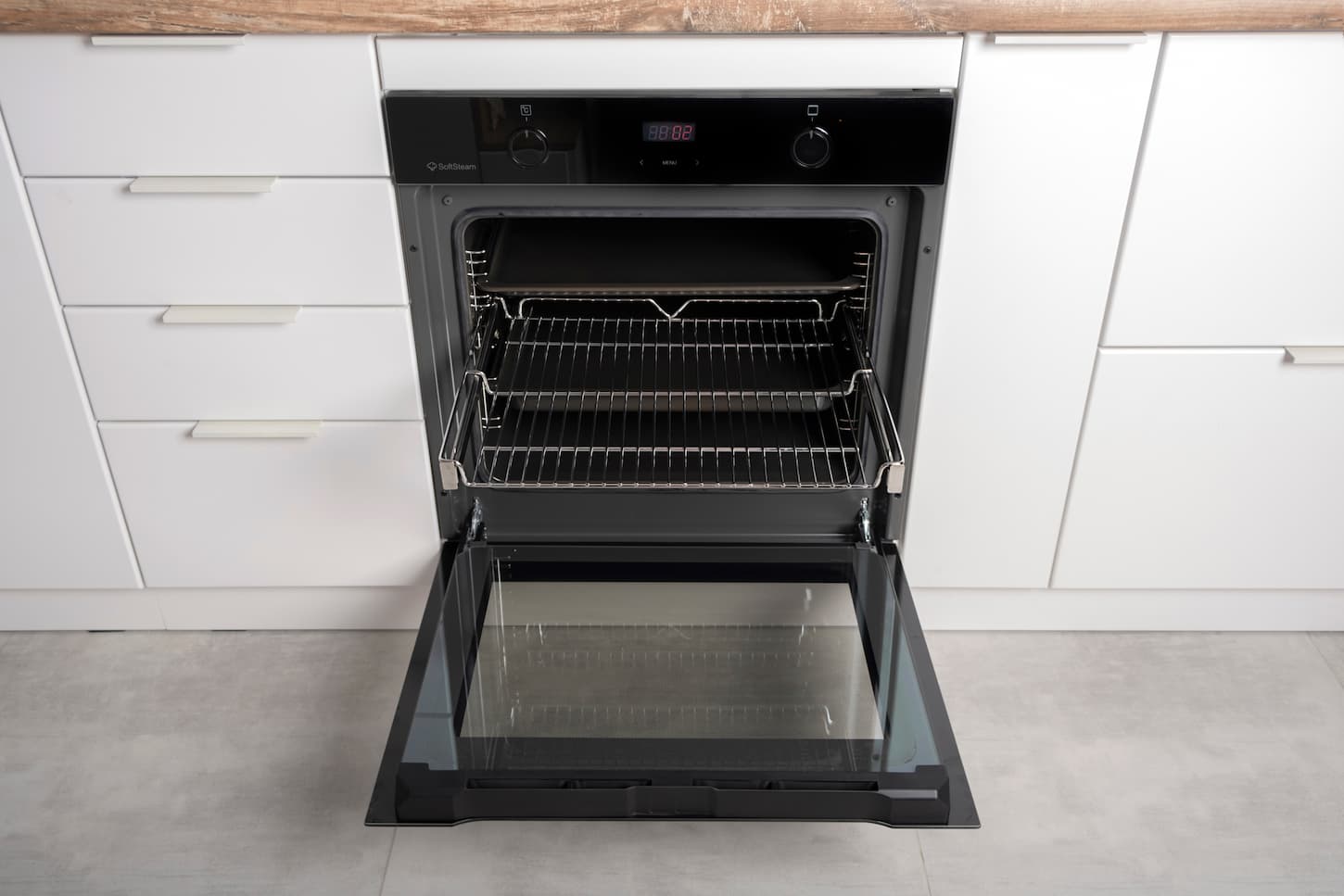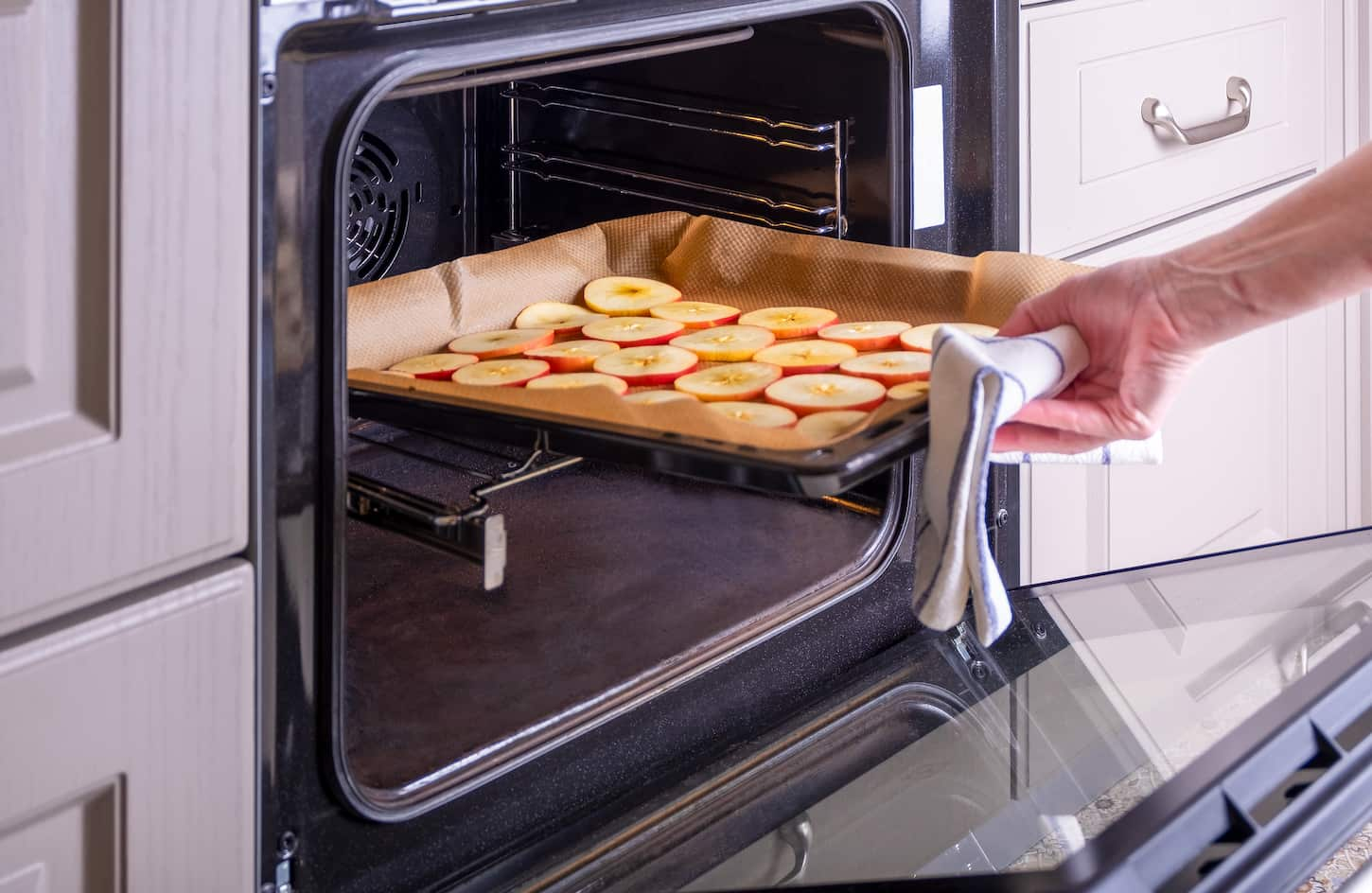Food dehydrators are handy devices that can prolong the longevity of food by a few years. However, many people have a problem with their price and look to their ovens as an alternative, wondering which is better – dehydrating in the oven vs. dehydrator?
Ovens are not better than food dehydrators by any metric, though they are generally cheaper since there is already one at home. Ovens generally take much longer than dehydrators to dehydrate food, and they use more electricity, require constant care, and can burn food more easily.
Unfortunately, ovens aren’t a good solution for dehydrators, but they can provide a temporary alternative for food dehydrators until you buy one. Read on to learn exactly what the differences are.

Does an Oven Work as Well as a Dehydrator?
An oven does not work as well for dehydrating food as a dehydrator does. Compared to a dehydrator, ovens are generally less efficient, take longer to dehydrate food, use more electricity, require constant care, and can burn food easier. Ovens get used as inefficient dehydrators due to convenience.
The only advantage of dehydrating in an oven instead of buying a dehydrator is the low initial cost – which is zero. We already have an oven, so we don’t have to buy anything.
Aside from that, there is no single advantage to using an oven over a dehydrator. They need more electricity, so we can expect that to reflect on our bill, and they’re not as good at dehydrating food as dehydrators.
- Oven-dehydrating takes at least twice the time and usually uses more electricity than a dehydrator, padding the monthly bill.
- Foods dehydrated in the oven often lose a lot of flavor.
- Oven-dehydrated foods often come out darker due to a higher oxidation rate.
- Finally, some ovens don’t have the option to set the temperature to 140°F, which is the maximum for most types of food dehydration. If we set our ovens above that temperature, the food will cook, not dry.
Dehydrators are the clear winners of the debate over dehydrating in an oven vs. dehydrators.
How Long Does It Take to Dehydrate in the Oven Vs. a Dehydrator?
On average, oven dehydration can take twice as long as drying in a dehydrator. Meats usually take the longest to dehydrate and can take three times longer in an oven than in a dehydrator.
The main reason for this is air circulation. Air constantly circulates in a dehydrator, but the same cannot be said for ovens unless it’s a convection oven (and the convection mode is activated). Since it’s difficult to keep a low temperature this way, the temperature constantly fluctuates, taking more time to dehydrate the food.
Additionally, food is prone to burning in the oven because of the lack of air circulation.
Let’s take a look at some comparisons for context (source).
| Food | Dehydrator Drying | Oven Drying |
|---|---|---|
| Apples | 6 to 10 hours | Up to 20 hours |
| Pineapples | 24 to 36 hours | Several days (not recommended) |
| Mushrooms | 8 to 10 hours | Up to 20 hours |
| Potatoes | 6 to 10 hours | Up to 20 hours |
| Jerky (marinated) | 3 to 5 hours | 7 hours or more |
| Onions | 6 to 10 hours | Up to 20 hours |
It’s safe to say that buying a dehydrator pays off if we’re seriously interested in drying foods.
If you enjoy turnips, here is an article that includes instructions for dehydrating and storing them so they last for years: How to Store Turnips (freezer, dehydrator, freeze-dried).

Is Oven Jerky Better Than Dehydrator Jerky?
Oven jerky is in no way better than dehydrator jerky. If anything, the risk of jerky scorching is much higher when drying it in an oven, which is almost impossible with a dehydrator. We prefer dehydrator-made jerky, as it develops an even dryness and is easy to make.
When discussing jerky dehydration, it’s important to know that the best jerky is marinated beforehand. On top of the sublime taste, it’s also easier and quicker to dry. Non-marinated jerky can take up to 24 hours to dry in a dehydrator and more than a day in an oven.
The best jerky recipe and marinade (also the marinade endorsed by the National Center for Home Food Preservation) consists of the following:
- 1.5 to 2 pounds of meat
- ¼ cup of soy sauce
- 1 tablespoon of Worcestershire sauce
- ¼ teaspoon of black pepper and garlic powder
- ½ teaspoon of onion powder
- 1 teaspoon of smoke-flavored salt (we use 1 tsp of liquid smoke flavoring)
Combine all the ingredients and cover the meat with the marinade in a shallow pan or sealed Ziploc bag. Let it soak in the juices overnight in a fridge.
Oven jerky: We can dry jerky in an oven by preheating it to 140°F. The rule of thumb is to dry it until the first piece of jerky cracks, but it should not break when we bend it.
To dry jerky in a dehydrator, use the same temperature setting and expect the first pieces to be done in about three hours, but they might take longer. We like thicker jerky, so a batch usually takes us 8 hours.
What’s the Difference Between Dehydrating in an Oven and a Dehydrator?
The biggest difference between dehydrating in an oven vs. a dehydrator is the oven’s inefficiency (usually caused by a lack of air circulation) and temperature fluctuation. Oven-based dehydration must be monitored constantly, making it a far more involved process than a hands-off dehydrator.
That last point is why many people buy dehydrators to dry food rather than relying on ovens. With a dehydrator, we can turn it on, go to work, or do some chores around the house. We will only need to check it once enough time has passed.
An oven, however, requires constant attention for two reasons.
- Firstly, since the temperature fluctuates due to a lack of air circulation, we must constantly check it with an oven thermometer. And we truly mean constantly – at least every half an hour. We must let the oven cool down if the temperature gets too high. Otherwise, our food will cook (and not dehydrate). If it drops down too low, we have to turn it up.
- The second reason we must pay attention to the oven while drying food is that it needs to stay open. The oven door must be propped open to allow the moisture to escape. Otherwise, the food won’t dry. It will just cook very slowly.
Open ovens can be dangerous if you have kids or pets running around.
Another reason to minimize oven use for dehydrating foods is its occupancy. We need the oven to cook, most likely daily, which isn’t possible if we’re constantly drying food.
Lastly, let’s mention that ovens use more energy and are more expensive than dehydrators. It takes more power and loses more power thanks to that open door. So an oven is far less efficient than a dehydrator.
How Much Does It Cost to Dehydrate in an Oven vs. a Dehydrator?
Dehydrating in an oven is several times more expensive than dehydrating in a dehydrator for the power used. Using jerky as an example, here are the power costs. Oven drying will cost about $2.66, while the dehydrator will only cost about $0.66, making the oven 4 times more expensive!
The math isn’t that complicated – a large dehydrator uses about 1 kWh per hour (depending on the manufacturer), and the average cost of 1 kWh in December of 2022 was $0.165.
- So, let’s say we’re dehydrating thin jerky slices (which can take 3 to 5 hours, so we’ll use 4 hours as a benchmark) today. After 4 hours of dehydration, we likely added about 66 cents to our monthly bill – not that much, right?
- Ovens, on the other hand, use about 2.3 kWh per hour of usage. Ovens can take twice as long (or more) to dehydrate foods. If we use them to dehydrate jerky, it can take about 7 hours (in an ideal scenario, but possibly more). In that case, we’re looking at $2.66.
But wait – there’s more. The prices only go up with the amount of time required to dehydrate. Okay, and prices always go up over time in general.
- Onions can take about 8 hours to dry in a dehydrator and up to 20 hours in an oven.
- Onions cost $1.32 to dry in a dehydrator but can cost up to $7.59 to dry in an oven.
The cost of oven drying grows exponentially, so we don’t recommend using them unless they’re the only option. The more we dehydrate, the more money we waste if we use the oven (compared to a dehydrator).

How to Dehydrate Food in a Dehydrator
Set the temperature to the 140°F or the temperature setting recommended by the manufacturer for the food. Put the trays in, close the lid, and set a timer. The manufacturer’s handbook will have a recommended timer. Check the food as needed. Repeat until the food is dehydrated. Store properly.
Your dehydrator should have come with a manual; that will tell you the exact temperatures and recommended timelines for dehydrating each type of food. It may even have some fun recipes you should try.
The nice thing about dehydrating with a dedicated dehydrator is this: you don’t have to babysit it. Set the dehydrator, set a timer, and check it as needed.
You can dehydrate any food (that can be safely dehydrated) in a dehydrator.
Have you ever wondered what the difference is between using a dehydrator and a freeze dryer? Check out this article for more information: Freeze Dryer Vs. Dehydrator: What’s the Difference?
How to Dehydrate Food in an Oven
Set the temperature to the 140°F or the lowest temperature setting, and put the tray in, leaving the door open by a few inches. Check the temperature twice an hour and regulate it constantly. Repeat until the food is dehydrated. Store properly once dehydrated.
The foods that perform best in an oven are meat jerky, fruit leathers, banana chips, and similar chips (pineapples and apples, for example). Vegetables might not do as well in the oven.
Dehydrating in an oven will take a lot of time, so clear the schedule for the rest of the day. We can’t dehydrate in an oven passively – we have to check on it twice an hour (at least).
After pretreating the food (different foods need different types of pretreatment, which we won’t go into in this article), set the oven to 140°F. We’ll need an oven thermometer to check the temperature constantly.
Once the oven’s heating up, put the tray in, but don’t close the door. Keep it open by at least two inches – this is the only way to achieve air circulation. If we don’t do that, the moisture won’t leave the oven, and the food will cook (painfully slowly).
Keep checking the temperature two times an hour – turn it up if it’s too low, or open the door completely and let it cool down if it’s too high. Keep doing this until the food is dehydrated.

Key Takeaways and Next Steps
Dehydrating food in an oven isn’t ideal, but it can be done. Meat jerkies perform especially well in ovens, albeit they take a lot of time to get done. It’s a complex process as we must watch the food and regulate the oven temperature.
We suggest only drying food in the oven until you get a dehydrator.
Don’t have a dehydrator and don’t want to use the oven in the meantime? Don’t worry. We’ve got you covered. Here’s how to make your own DIY dehydrator – and we’ve got several build options for all budgets.
Resources
Learning from your own experience is essential, but learning from others is also intelligent. These are the sources used in this article and our research to be more informed as homesteaders.
- Drying. National Center for Home Food Preservation | How Do I? Dry. (n.d.). Retrieved January 17, 2023, from https://nchfp.uga.edu/how/dry/jerky.html
- How do I . . . dry? National Center for Home Food Preservation | How Do I? Dry. (n.d.). Retrieved January 17, 2023, from https://nchfp.uga.edu/how/dry.html
- Introduction to food dehydration. University of Missouri Extension. (n.d.). Retrieved January 17, 2023, from https://extension.missouri.edu/publications/gh1562
- UGA Publications. National Center for Home Food Preservation | UGA Publications. (n.d.). Retrieved January 17, 2023, from https://nchfp.uga.edu/publications/publications_uga.html
- U.S. Bureau of Labor Statistics. (n.d.). Average energy prices for the United States, regions, census divisions, and selected metropolitan areas. U.S. Bureau of Labor Statistics. Retrieved January 17, 2023, from https://www.bls.gov/regions/midwest/data/averageenergyprices_selectedareas_table.htm
